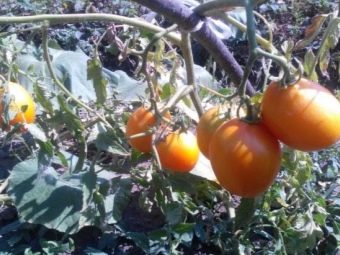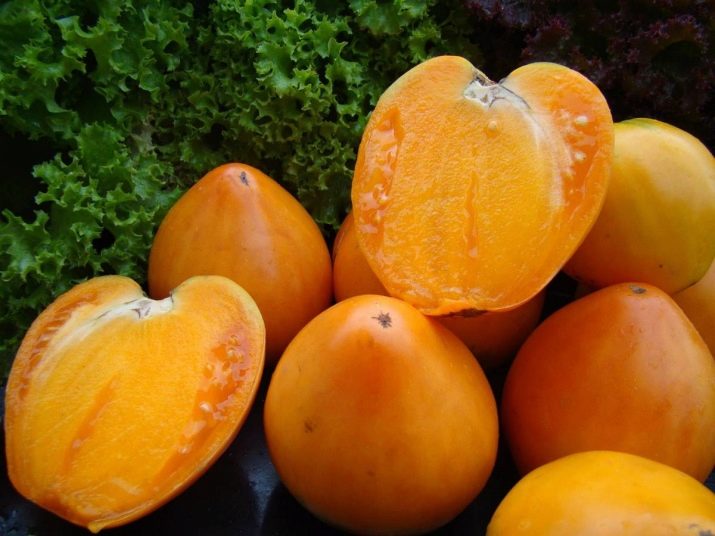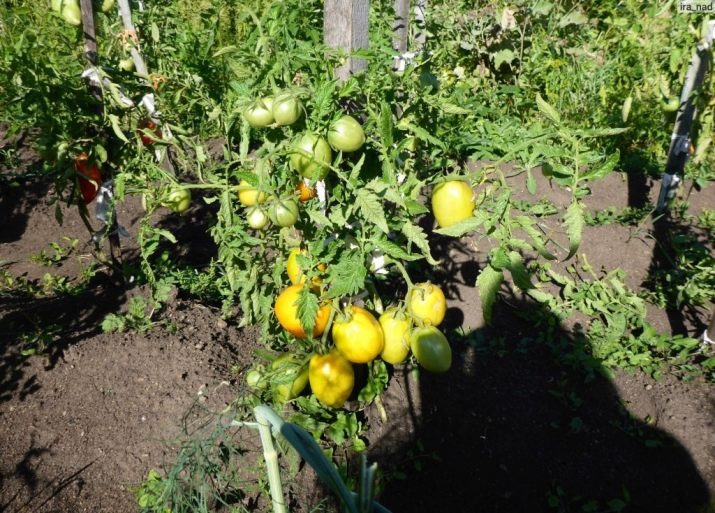Description of the variety of tomatoes "Golden Heart"

Both beginners and experienced summer residents will be interested to learn about the merits and demerits of the Golden Heart tomato variety.Our article will give recommendations on planting and cultivating the variety, and also will tell you about the detrimental effect on these plants.
Special features
In 1999, the breeder Yuri Panchev obtained the “Golden Heart” tomato variety, and in 2001 it entered the State Register of the Russian Federation as suitable for cultivation in open beds. Practice has shown that for the perfect ripening of tomato "Golden Heart" is suitable not only unprotected soil, but also greenhouses made of glass, greenhouses. The climate of the northern regions does not allow tomatoes to grow on the open surface, so the “Golden Heart” bears fruit only in glass-covered rooms, greenhouses.
The variety has an original shape in the form of a heart: the tip of the tomato is pointed downwards. On the stem you can see ribbing. The fruit has a bright yellow-orange color. The skin is glossy.
The density of the skin protects the tomato from cracking. Multichamber fruits. The flesh is juicy, watery, with a small amount of seeds. The taste is very delicate, sweetish, without sourness.
The main characteristics of the “Golden Heart” tomato variety are that it ripens early and bears fruit throughout the entire season until late autumn. From the emergence of shoots to full maturity, 90-95 days pass, in the southern regions of the country - 80-85 days. Gardeners celebrate high yields.
Golden Heart Tomatoes are determinant plants, that is, with limited growth. On the beds, they look compact: the height of the bush does not reach even one meter. In the greenhouse bushes can be longer, sometimes their growth is doubled.
On each plant there are small dark green leaves, of which there are many. One tomato weighs from 120 to 200 g. Gardeners note that with good care, the weight of one fruit can reach 300 g
Usually 5-7 tomatoes concentrate on the brush. 7-8 kg of selected tomatoes can be removed from each square meter, and up to two and a half kilograms from one bush.
Green fruits ripen perfectly at room temperature. This vegetable is consumed in any cold dishes, added to soups, side dishes, canned, pickled. Tomatoes can be preserved whole.
Tomatoes of this variety can be stored in the refrigerator for two weeks. Suitable for freezing in small pieces. After thawing, the shape of the tomato slices is maintained. All sorts of thick sauces, excellent tomato paste, tasty lecho are made from ripe fruits. Very useful aromatic fortified juice is produced.
Advantages and disadvantages
The undoubted advantages of the “Golden Heart” tomato variety are excellent taste properties. Tomatoes look very attractive: yellow-orange heart-shaped fruits with a thin, but at the same time dense skin. Fruits long remain beautiful, do not crack, well tolerate long-term transportation.
The inside of the fruit is fleshy, soft, low seed and very juicy. Tomatoes of this variety do not have pigments that can provoke allergies. Tomatoes are saturated with many trace elements, vitamins, contain beta-carotene, iron. Good for baby and diet food.
Gardeners leave many positive reviews about this variety of tomatoes: high yield, compact bush, resistance to fusarium, blight and other diseases. There is no need for obligatory hilling of a plant. The tomato tolerates cold, drought, lack of water. Ovaries appear in extreme heat and cool.
The disadvantages of this variety include capriciousness, due to which the planting should be treated more scrupulously. It is necessary to form a bush. Requires nutritious acid soil mixture, a specific irrigation schedule.
Landing
It is important to know the following nuances of landing.
- Seed material begins to be planted in mid-February.Before sowing, the seeds must be placed on cotton wool moistened with a weak solution of potassium permanganate for half an hour, then rinsed with clean running water. It is desirable that the water was cool. This procedure will prevent illness, at the same time it will be possible to check the quality of the seeds.
- For disinfection of seed material, Vitavax 200 FF and Maxim preparations are well suited. If the seeds were purchased at specialized points of sale, they were subjected to industrial processing, therefore, they should not be processed at home under a solution of potassium permanganate.
- Capacities for planting seeds can serve as special containers, glasses with a width and depth of 12 cm. Boxes are also used. You can buy ready-mixed soil in horticultural stores. Experienced vegetable growers mix peat with turf and pour river sand into this composition.
- Immediately before planting, it is necessary to calcine the soil and carefully sift it in order to completely disinfect it and prevent possible diseases in the future. Some growers recommend stratification. Seeds, wrapped in a damp cloth, put in a small container and left in the refrigerator for two days. Then dry the seeds on a paper napkin and treat with a growth stimulator.
- Next, the container is filled with soil, watered. Tweezers laid two seeds to a depth of one and a half to two centimeters. Then the seeds are sprayed, sprinkled with dry peat. Sowed covered with plastic transparent film or glass. Capacities with seedlings are left in a heated room with an optimum temperature from +23 to +25 degrees.
- Three days lasts waiting for the first shoots, but they may appear a few days later. When they appear, the temperature must be reduced to 16 degrees. The film is removed, and the containers with seedlings are moved closer to the fluorescent lamps or to the sun. It is necessary to systematically take care of the seedlings: water regularly, carry out hardening, carry out 2-3 additional feeding with chopped nitroammophoska (15 grams per 8 liters of water).
- Properly formed sprouts of tomatoes should have a height of 20 to 23 cm, be strong and bright green. The root system can reach 12-17 cm, the thickness of the root collar - 2-4 mm. After the appearance of the leaves, you must dive sprouts. When sprouting the seedlings should be deepened to the cotyledon leaves. The second pick is needed when the leaves of neighboring plants begin to touch, and the above-ground shrub itself exceeds the size of the coma.
Growing tips
Pay attention to the following recommendations.
- Sunlight is a must for growing Golden Heart. Tomatoes should not be allowed to be shaded by trees, other cultures, fences. It is recommended to plant the plants on the beds not protected by foil in the middle of May. It is important that the frosts pass, the weather is warm. In greenhouses, planting of seedlings begins in April.
- Land must first dig up and level. It is recommended to pre-water the soil with boiling water. In the holes measuring 20 cm wide and 18 cm deep, place 10 g of nitroammophoska and 100 g of rotted manure or one tablespoon of superphosphate mixed with wood ash. Then the sprout is placed in the center of the hole, the roots sprinkled with dry soil. On one square meter it is advised to place only three bushes. The gap between them should be from 30 to 45 cm.
- For good rooting of seedlings you can use a stimulant. The bush must be formed: remove all lateral processes, leaving one or two stems. Some recommend pinching a growth point, while other growers find it unnecessary because of the Golden Heart determinism.
- Branches with tomatoes tie up. Attach the twigs preferably to the trellis. Then the bushes do not fall down on the ground, they will not rot.
- It is recommended to feed the plant with mineral complex fertilizers 3-4 times during the season. The dose should be moderate so as not to burn the bushes. Compost and manure can be used as a natural nitrogen fertilizer.
- To get a good harvest there is an easy way to form a bush: there should always be one central escape, so all stepchildren are regularly cut off. All lower leaves are removed before flowering. To grow large fruits, some flowers must be removed.
- Watering the plants is recommended with settled water, the temperature of which should be between 20 and 24 degrees. From the use of cold water ovaries may disappear. Watering is carried out at the root, it is undesirable to get water on the leaves. Topsoil should dry slightly before the next watering. Open beds are watered in the early morning, greenhouse tomatoes - in the afternoon.
- Planted recently transplanted seedlings need to be watered often, preferably once every two or three days, spending 3 liters of water for each bush. A month later, watering is carried out once a week; 8 liters of water are used per plant. On hot days, watering tomatoes should be more often than usual; water should be spent 10 liters per bush. To maintain moisture, the soil is mulched with straw, hay, cut grass, peat, or humus.
- It is recommended to air the greenhouse in a timely manner. If the plant receives a lot of fresh air, the root zone and the tops of the bushes will be less susceptible to rotting. It is necessary to periodically remove the leaves from below, destroy excess grass, loosen the soil to prevent cracks and crusts.
Diseases and pests
This variety is not prone to disease, however, it would not be superfluous to take preventive measures.
- In the greenhouse, the upper layer of the soil should be changed every year.
- In order to prevent diseases of the “Golden Heart” tomato variety, one should never choose the beds where potatoes, Physalis, peppers, eggplants or other types of tomatoes were grown before. Seedlings can be placed where previously grew cucumbers, zucchini, carrots, pumpkin, onions, lettuce, beans, cabbage.
- With a shortage of sun and excess moisture may cause late blight of tomato. This happens in rainy summer. For preventive purposes, the soil is treated with a solution of potassium permanganate or copper sulphate. Periodic use of drugs containing copper prevents fusarium and late blight. A weak solution of potassium permanganate can destroy the fungus.
- Insects are the main enemies of the Golden Heart. Colorado beetles are especially dangerous. Its larvae can destroy the entire ground portion of tomatoes within five days. In the fight against the Colorado potato beetle, the prestige, Komandor, Regent, Apache, Shedevr, Tabu, Molniya, etc. medicines are recommended to be used. Batsikol and Dendrobatsillin.
- The plant can suffer greatly from aphids, whitefly, spider mites and thrips, which destroy fresh greens. In the fight against pests will help modern chemicals for the extermination of harmful insects. Saves sprinkling decoction of bitter wormwood, infusion on onion peel. To protect themselves from spider mites helps the broth of celandine, soapy water does not give any chance of surviving aphids.
- Ammonia will destroy the whitefly and thrips. Some summer residents to repel harmful insects grow garlic or beans with tomatoes.
- Curled leaves and leaves with dark spots should be immediately cut off, and the plant treated with non-toxic means.
See the next video for more information on the Golden Heart tomato variety.


































